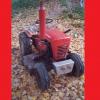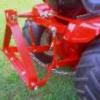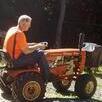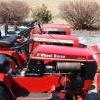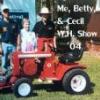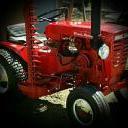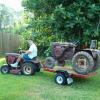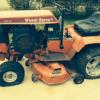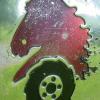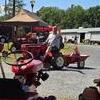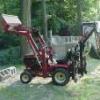Leaderboard
-
in Posts
- All areas
- Markers
- Marker Comments
- Marker Reviews
- Articles
- Article Comments
- Article Reviews
- Classfieds
- Classified Comments
- Classified Reviews
- Wiki's
- Wiki Comments
- Wiki Reviews
- Blog Entries
- Blog Comments
- Images
- Image Comments
- Image Reviews
- Albums
- Album Comments
- Album Reviews
- Files
- File Comments
- File Reviews
- Posts
-
Custom Date
-
All time
November 28 2011 - November 27 2024
-
Year
November 27 2023 - November 27 2024
-
Month
October 27 2024 - November 27 2024
-
Week
November 20 2024 - November 27 2024
-
Today
November 27 2024
-
Custom Date
10/24/2023 - 10/24/2023
-
All time
Popular Content
Showing content with the highest reputation on 10/24/2023 in Posts
-
9 points
-
8 points1/2 day for my niece Leighty Bug ofay. We took a ride on Putt Putt, then did a little recreation picture. No cukes available, I guess a Reese’s peanut butter cup will do…
-
6 points@ebinmaine it might be worth a conversation with Norman letting him know you and folks on this forum are having problems with the QC on the carbs. Maybe he can source from a different manufacturer. Norman provides a great service to old tractor owners and given the volume of buyers from this site he might want to hear about it. Just a thought.
-
6 pointsThose are fairly easy to shorten and rebend - cut the new cable Z off and remove the inner cable to cut the outer sheath and not damage the cable. Reinstall the inner cable, lightly lube it before you do - Marvel Mystery Oil works great. Loosely install the shortened assembly BEFORE you do the "Z" bend. Cables have a natural curl to them - mark the direction you want the Z to end up pointing to. Then add the double bend. This allows for better free motion not fighting a twisted cable. Practice on the part you cut if needed. Not having a "Z" bend tool, I have used the choke lever from a scrap carb as a mandrel with excellent results..... Bill
-
5 pointsMrs P's game plan: Kevin plans plow day; Kevin cleans sheds to prepare; Kevin discovers many wonderous 's and bits and pieces that visiting plow dogs may ... leaving sheds cleaner with more room for another Senior... Mrs P's smart girl...
-
5 pointsYou need to get a book called Strait from the Horses mouth @Keaton. Three editions available and gives a very complete horse history. This is the third or final edition. I read it two dozen times and now that I got it off the shelf will read it again!
-
5 pointsIt wasn’t as user friendly as a machine with a steering wheel, but it did the job well!
-
5 pointsBefore the Senior was the Lever Steer. That was the true beginning. Here are some fine examples of those…
-
5 points
-
4 points
-
4 points@Pullstart I’m not sure if you’re aware of this Kevin but you have a lot of “stuff” !! My brother says to me that I’m suffering from TMS, Too Much Stuff!
-
4 points
-
4 pointsSee if you can still buy from this company. I see they have online shopping now.
-
4 pointsAnd, don't forget three other rebranded oddities sold by Wheel Horse - @SylvanLakeWH's favorite - the battery powered GE ElecTrac riding mower, the obscure WH 'Safari" Snowmobile.... and the REO walkbehind Snowthrower.
-
4 pointsThe lift on these decks is not quite in the center, so it will tilt if it's not pulled up tight against the stops. May need to shorten the lift chain a bit. Or longer shot, one of the rubber bumpers may be damaged.
-
4 pointsNot all chicom carbs are equal...the majority of carbs i sell are aftermarket, keep in mind that Briggs has been using Rux Ing chinese carbs as oem for about 5 years, Honda factory carbs are Chinese, some Kohler as well. I started delving into Chinese carbs when factory carbs doubled in price a few years ago with a decline in quality...i figured if im going to sell sketchy parts i mighy as well maximize the value. Quickly saw issues...but then i found "Kipa" carbs..on Amazon and their quality/performance has been very good for me. Alot goes back to low quality fuel, not ethanol as much as fuel being garbage.
-
4 pointsi have also purchased carbs and rebuild kits from IST --- regarding the specifications of the IST carbs mentioned in the thread........ as well as the threads comments regarding communicating with Norman.. i do recall on his site, or maybe even in his videos, that he says his carbs are produced to his "specifications"? I may be recalling incorrectly, but if he does spec his carbs, maybe your conversation with him would have value because then he can redesign/adjust the spec to accomodate your perspectives, insights and experiences?????????? Bill
-
4 pointsThe seat has been wobbly on my GT-1848 for quite a while, and the bad habit of putting a hand and lots of weight on the seat back when getting on and off had made it worse, so I decided it was time to see what was going on. The metal was cracked on both sides where the cross brace that the seat hinges attach to (sorry, no picture, but I'm guessing most of you have seen this kind of damage before). I thought about welding some new metal on there, but realized that I had a cross brace that went further up to reach the next set of holes, so I went with that. While I had the seat and fender off I replace the mangled hydro fan, cleaned and lubed the hydro linkage and fins, and dropped a new seat on it. I also had found this old toolbox which I painted red, made a bracket for it and mounted it on the fender. I think this will come in handy. [ yeah, I know the deck looks bad - this is the worst of 3 48" SD's I have, been using it out in the fields. It will probably get some TLC this winter.... oh, and a WH logo will eventually replace or cover up the B&S logo the PO put on the Honda engine. ] No pictures on this yet but I did some work on my 417-H steering column, and started fabbing a motion pedal for it.
-
4 pointsHave them on our page in the classifieds / with hardware / with replaceable ends / pre-painted
-
3 pointsThis is probably a bit more than you were looking for but can't resist sharing it with you. Wheel Horse started in Elmer Pond's garage in 1946. Mr. Pond started building two-wheel garden tractors using surplus parts. Within ten years, his business had become very successful and began to build a full line of lawn and garden tractors, in addition to riding lawn mowers. This is a story that starts out way before the brand name "Pond" or "Wheel Horse." It starts out with the name "Shaw." Elmer Pond and his associates, Glen Hielman and Harold Pond worked for many years for Shaw making tractors. These tractors were produced out of motorcycle and automotive parts and were made for the bigger gardens and small orchards. After a while the three men decided to build their own tractor and go into business for themselves. Harold Pond had worked for Shaw since the 1920’s and decided that he would make a tractor known as the Speedx Model "B," and Pond garden tractor in 1938, which would be one of the first four-, wheeled garden tractors. Glen Hielman would make the "Garden Master" in 1952. After World War II, Elmer Pond took the advantage, as did the other two men, to make a smaller lawn tractor that could do the work of a garden tractor and a lawn tractor. People who had a small garden didn’t need or want a big tractor for the small jobs they had to do, so they depended on these men for their garden needs. Another reason smaller garden tractors became very popular was that these tractors were rather inexpensive, so even the typical family could own one of these tractor and maintain it for a low cost. Many of these tractors were made from small air-cooled engines, drive systems, axles, wheels, tires, and other various parts that could be found. The framework was made from pieces of angle or channel iron. Elmer Pond started production in 1946 in his two-car garage in South Bend, Indiana. These tractors were made from crude parts that could be found. He produced a two-wheeled tractor that was self-propelled, which was sold under the Pond name. Pond made these for nine years, known as the "Walk- Away's " because the design of the tractor. After the first year of production Pond decided to make a four- wheel tractor. This tractor was made from crude parts such as a model "A" transmission, an 8.3 Wisconsin engine, Tiller steering, and much channel iron. The tractor was known as the Ride-Away Senior and was mainly for garden use. This model of the Senior was designed without a hood for easy serviceability. In 1948, Major changes occurred to the business and the tractors. Cecil Pond, Elmer Pond’s son, joined his father to make a partnership that would last for a long time. The tractor they created gained a fiberglass hood, and a Ross steering gear. The Ride-Away Sr. was produced for another seven years with small variations. In 1955, Pond started to make three different tractors, including the Walk-Away, Ride-Away Sr., and introducing the Ride-Away Jr. This new tractor would have a 2.5 HP Briggs and Stratton, or a 3.6 HP Clinton engine that would satisfy the needs of the typical house hold. The small tractor had a unique engine mount located between the driver’s legs and a belt driven transmission, "Variable speed." Pond made it so that you could put many different attachments on these tractors by welding brackets on them or making simple attachments that sold under their names. By the end of 1957, Pond had exceeded $1,000,000 dollars in sales. During the next years, a change would happen to the tractors; they would stop producing the Sr. after the first year of selling the little Jr.'s. They also changed the steering wheel on the smaller tractors from cast-iron to a larger diameter steering wheel. A new model was produced in 1958, which included a three-speed transmission. This transmission is called the Uni-Drive transmission that Elmer Pond designed in 60 days. The Rj-58 was the name of the model and it included one of the following engines: the Clinton B-1290 was used along with the Kohler k-90 were used to drive the small tractor. The Rj-35 had a Clinton B-1200 was used to drive the belts to the gearbox to move the tractor. They also put a Briggs 2.5 HP engine, which made the model of the tractor the RJ-25. The attachments remained the same for the RJ series. From 1956-1957 wheel horse changed the color of the wheels. They changed them from black into an almond color. The demand for these little tractors grew so much by the end of 1959 that they couldn’t keep up with production. But, they still made over 4,500,000 dollars. In 1960 there were significant style changes. However, the engine location immediately in front of the operator and the 12-inch wheels stayed the same. Two models of tractors were introduced this year: the model 400, with a four-horse power Kohler engine and the model 550, with a 5.5 horse power Lauson engine. These two models were known as the "Suburban" tractors. During this year the company obtained property on 515 W. Ireland Road. South Bend, Indiana. This plant was constructed in 1961 and occupied in July and August concluding of the 1961 production year. These two successful models continued until the next year known as the 401, 551,701. This was the first year for the front mounted engine tractor. Wheel Horse made the 701 with a 7-horse power Kohler engine. A change in transmission from two side plates and a piece of cast to two pieces of molded cast that went together instead of three. All models remained the same from 1961 to 1962 with all having the front mounted engine. The models were called the 502, 552, and the 702 the hood was a major appearance change. In 1961 they had an aluminum gas tank and a unique hood shape with a slotted grill. Also this year Wheel Horse produced the 32R and 32E, which were named Lawn Ranger, and they were made for lawn care only and removal of snow. In 1963 all five models remained the same as in 1962. The new product introductions for 1963 were the model 953 tractor and the model RM 483 48-inch mower. The garden tractor had a 9.6 horse power engine and 15-inch wheels with 27-inch tires. The model 953 unit was the first of the "large frame" garden tractors offered by Wheel Horse. In 1964, an 8-horse power Kohler engine replaced the 7-hp engine in the model 854. The model 953 was updated to the model 1054. At the beginning of the model year Wheel Horse acquired the REO product line from Motor Wheel Co. This product line consisted of walk behind rotary power mowers and walk behind snow throwers. Walk behind tillers and a rear-engine-riding mower also acquired but were closed out and never put into production. Sales volume in this year exceeded 11 million dollars. 1965 was the first year for the infinite speed shift system to the industry. A Stundstrand hydrogear unit was added to the Wheel Horse "Uni-Drive" transaxle. Tractors using the automatic shift were called "Wheel-a-Matic" tractors. The new "Wheel-a-Matic" models were the 875 and the 1075. Other products introduced in 1965 included a new 42-inch rotary mower attachment, a "REO-Matic" rear engine riding mower designed by Wheel Horse, and a completely revised line of REO power lawn mowers. The 1966 model products were unchanged from 1965 except for the addition of a 12 horsepower, automatic shift garden tractor and a 36-inch tiller (RT-366). The large frame model 1054A tractor was dropped from the line. Sales volume in this year reached 19 million dollars. 1967 saw the emergence of the "six speed" tractors. A Hi-Lo range was added the "Uni-Drive" transaxle to obtain six speeds forward and two reverse speeds. The new six speed tractors were the 867, 1067, and the1267. The Lawn Ranger models L-107 and the L-157; "Short Frame" models 607, 657, 877; and "Long Frame" models 1057, 1077, and 1277 were also in the 1967 line. In 1968 Wheel Horse began the model naming process, Commando (3 speed), Raider (6 speed), Charger (automatic), and the Electro (Automatic with electric clutch). They also had full-length footrest; and "B" section drive belts were added to the long frame tractors. Also in 1968 there was a "500" special tractor that was sold to dealers in Indiana, Illinois and Ohio in a promotional event tied into the Indianapolis 500-mile race. In 1969 they initiated more new products than any other year in Wheel Horse history. Wheel Horse’s first 14 horsepower tractor called the GT-14 was at the top of the line. It was a large frame tractor with 27x 9.50-15-rear tires. A new series of tractors using vertical shaft engines and a new vertical input transaxle was introduced. The spring of 1969 saw the opening of a new plant in Geel, Belgium called Amnor N. V. Wheel Horse lawn tractors are known for their standardization across the years. In the 1986, Wheel Horse was purchased by Toro. Toro continued to build garden tractors using the Wheel Horse name until 2007.
-
3 pointsMy rope lighting malfunctioned in the back barn. It worked great but wasn’t the brightest. I bought two of these 10 packs for $89.99/box and so far, the 6 I have installed are amazing! Oh look, I found some tractors I forgot I had! just kidding, I wouldn’t forget about them!
-
3 pointsI don't buy into the narrative that lower octane fuel is any less refined or "clean" than high octane. I actually believe that "premium" fuel is a bit of a misnomer as it is less "explosive" in order to eliminate preignition in high compression chambers...but I could be way off and it wouldn't be the first or last time As for ethanol, other than being very destructive, it's inefficient. I burned 3 tanks of E85 in my Yukon to see how it performed and I lost over 3 mpg! EDIT: My apologies about the fuel, and I wouldn't want to be Norman trying to source quality aftermarket parts these days.
-
3 pointsThat's one a them “ventilated” plows, isn’t it!? I foresee a ‘tube video on how to “un-ventilate” a snowplow.
-
3 points@davem1111 it would be a great idea to cut those wheel weight studs right down tight. Shin killers right there, ask me how an know!
-
3 pointsGot it, thank you for the images! I figured out the front of the deck leveling, the screw adjustment was all the way up on the knob.
-
3 pointsFuel quality might be a small part of the problem, But the real big problem is them selling "Universal " size carbs. If the throat size is to small its like putting a #26 12 hp carb where a #30 16hp carb should be used. The engine might idle OK, but will struggle when loaded up, Just my 2 cents!
-
3 pointsI no longer have the decks, but here is the idea. A bar and two bolts to hold the assembly together. The bar would have to be longer of course. In an earlier post you said the front of the deck elevation was not changing when you adjust the rear height gage wheels. I asked you to check if the notch on the front support bar was engaged properly. This is the notched bar that must be hooked on the rear rod on the mid attach-a-matic . The deck will not lift properly if this is not assembled properly.
-
3 points
-
3 points
-
3 points
-
3 pointsThe early walk behind was called Walk Away, the RS-83 was the Ride Away Senior and the RJ meant Ride Away Jr.
-
3 pointsWheel horse actually started out with walk behind tractors. The first RJs were supposedly walk behind tractors with front wheels and a seat added. That's why the engine was located so close to the rear wheels. Wheel Horse also made dozens of implements. Most don't realize that even the last 2007 model "Classic" series and all previous came from the manufacturer as the tractor only. Mowing decks and any other implements were added by the dealers.
-
3 points
-
3 points
-
3 pointsI’ll add a bit, I want to make this tractor perform flawlessly and last forever. If the 42” deck is worth time/effort to do so, I’ll keep it. If not, I’ll try to find a 48 or a 37 deck. I want a deck I can know is durable and will last. I’d prob be fine running a 48” deck with 12 HP also as I’m only cutting a very nice Bermuda lawn at around 2”. However, if I have 8” front wheels, can I even run a 37” deck? Here’s current deck/tractor setup. I had posted some about this in my other thread, but wanted to really focus on the deck here. Deck heigh adjustment bracket is bent, need ideas in fixing that as well if I keep this deck.
-
3 pointsI have never had any problems with IST carbs , have 3 running right now 2 on Magnums and one on a K181. May be I have been lucky.
-
3 points
-
3 pointsLikely you'll want to trim the replacement cable(s). A "Z" bender and good pair of wire snips will work fine.
-
3 pointsmy guess is that lift handle has been apart disassembled from mower shell ? -- i suggest you check the shell carefully for fracture lines -- both where the lever handle bracket has bolts that go through to underneath of shell ... as well as the two bolts in black bracket clamp to the left that hold the axle connected to the shell. Those are major stress points n shell -- I also suggest you consider replacing the red screw/bolts that hold the lift height lever bracket to shell and replace with carriage bolts that have the heads underneath the shell.... and have the nuts on the "top" outside of the shell..... that way you avoid the nuts and the bolt threads being underneath the deck on the bottom where the nuts and threads will be damaged and corroded. That problem will be avoided by having the carriage bolt heads "flush" underneath coming up to the top outside of the bracket which is the way the black bracket bolts and nuts were installed. Good luck, Bill
-
3 pointsYep, wife and I spent a couple days up there. I went it before it opened (it’s a nightclub and not really a restaurant) and managed to get the last t-shirt they had.
-
3 points
-
2 pointsOddly, we have one of these on our 312-H--unlikely to be original to that tractor! I was thinking of swapping it with the “ordinary” one on the 854 -- more authentic, don’t you think -- and then remembered the “if it ain’t broke...” axiom. I haven’t used an electric pump, as three of ours are standard camshaft lever pumps. Two got “new to us" cleaning/overhaul and new diaphragms. The fourth is the standard pulse pump on the Onan. All work just fine--a few extra seconds cranking to start after a longish sleep is ok with me.
-
2 pointsI for one am a huge fan of the OE pumps with the priming lever. Have one on my 854 and Dad's 702. Watch out for fuel leaks at the lever "seal". Bill
-
2 pointsJust to tie this into the thread- the tires below are NHS 16x7.50-8. They measure exactly 16 inches tall, and just over 7 inches wide. About 7 and 1/4 is closer to the actual. So 18x9.50 are only an inch wider each side of the rim (assuming the tire actually measure as it should), so you should have no problems.
-
2 pointsYeah, very true. My main goal will be to get and keep this current 42" nice. I think I'll still get some steel cut and start welding just to see how it turns out. It'll take me a while as I do not have much free time right now, but I need some practice anyway!
-
2 points
-
2 pointsI've never tried any aftermarket carbs, though I have been tempted to try one. I buy a lot of stuff from isavetractors but just never got a carb. I'm working on a briggs with a one piece flo jet carb that has a non replaceable seat in it that is shot and can't find an OEM briggs carb so I may have to try a china carb for it.....
-
2 pointsThought @Sparky posted a pic of that a while back too. I haven't been up there for about 10-12 years now but loved it when I was there. Nice clean and safe. There were families walking around with kids at 7-8:00 at night. Lots to do and the area is beautiful.
-
2 pointsLooks fine from here. At least you still use it! Very few man made items these days still in use after 50+ years. Paint fades... But the deck still works!
-
2 pointsTo me, tierods, PTO friction plates, and brake bands are items that buying used is a waste of money.

